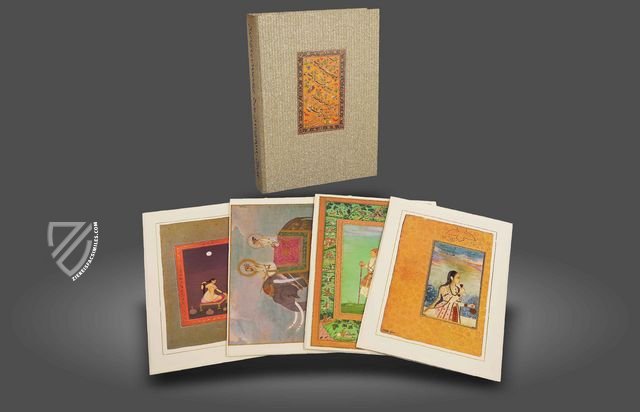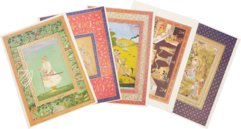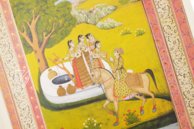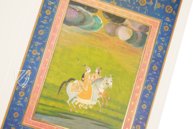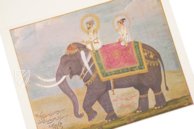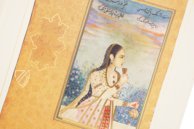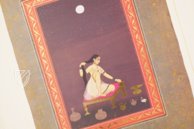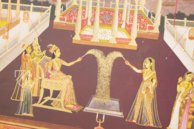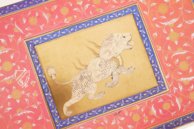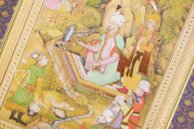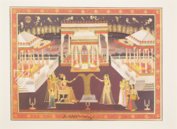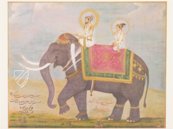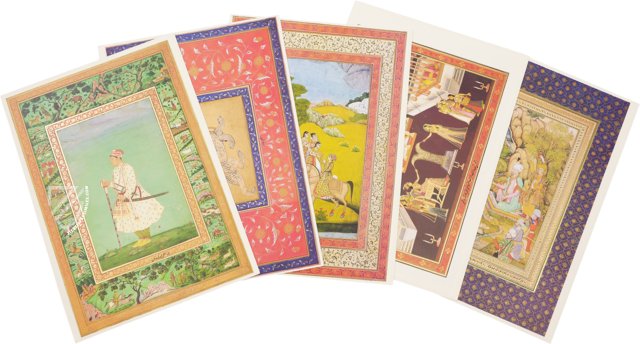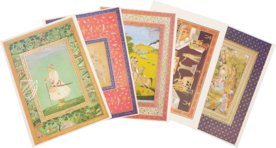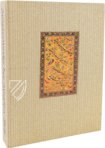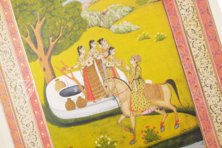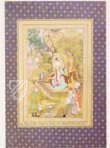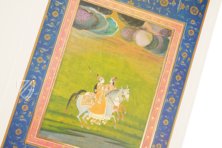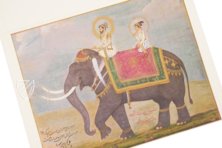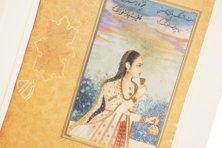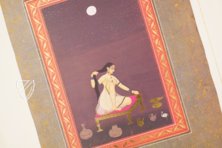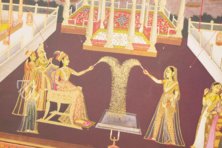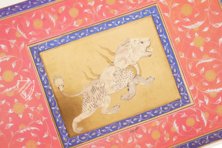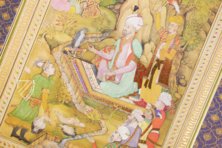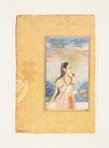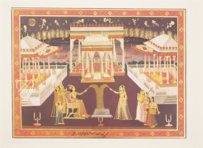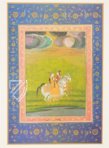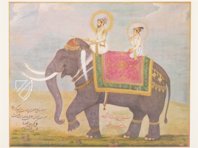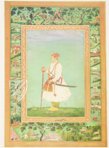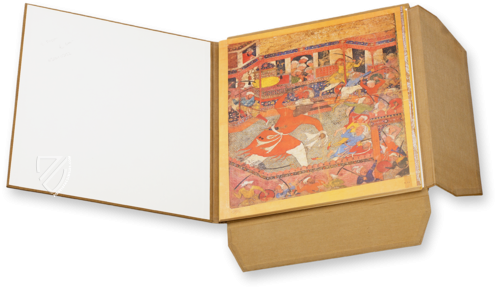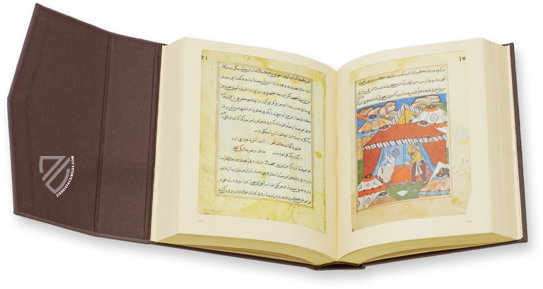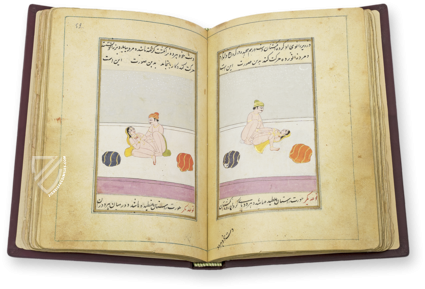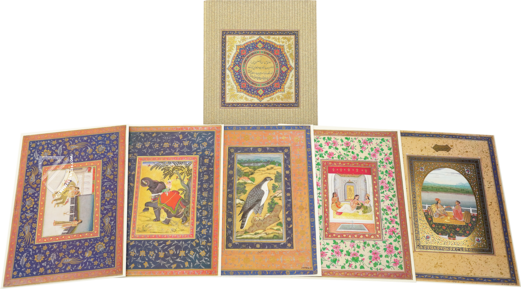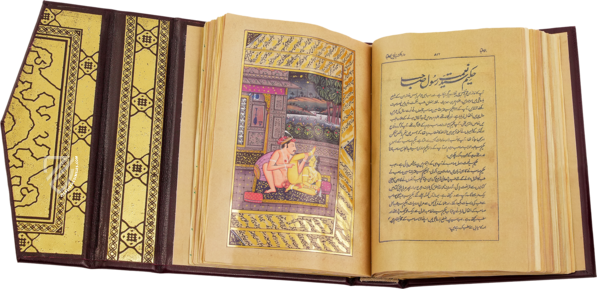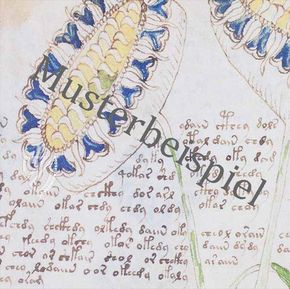Masterpieces of the Moghul Era
(under 1,000€)
The Mughal (or Mogul) Empire ruled over most of South Asia for more than three centuries and aside from being the richest state of the period, it developed its own unique artistic style. Mughal painting blended indigenous Indian art with Islamic, Persian, and even Chinese influences to create a particularly refined and elaborate aesthetic. Mughal miniatures had a distinct influence on successive artistic styles, particularly in northern India.
Masterpieces of the Mughal Era
Founded in 1526, the Mughal Empire was an Islamic superpower that ruled over most of the Indian subcontinent and parts of Afghanistan for 325 years. The ruling class could trace their roots to both Genghis Khan (ca. 1162-1227) and Timur (1336-1405) also known as Tamerlane, but became increasingly Indian and Persian due to dynastic marriages. At its height, Emperor Aurangzeb (1618-1707) ruled over one quarter of the world’s population as well as the largest economy in the world with a GDP ten times that of France under Louis XIV (1638-1715).
This tremendous wealth, when paired with the massive polyglot population, produced a rich cultural and artistic heritage. It evolved from Persian miniature painting, which was itself heavily influenced by Chinese art, in addition to influences from the Hindu, Jain, Turkic, and Buddhist artistic traditions. It is distinguished from its Persianate predecessors by adopting a more realistic style for plants, animals, and portraits. Other elements of the Persian artistic tradition, especially richly decorated borders, were continued and refined.
The ten folios assembled here represent a splendid sample of this rich, diverse artistic tradition created between the 16th and 18th centuries:
1. Emperor Babar Resting During the Hunt, 1st quarter of the 17th century, Mughal school.
2 Dara Shokuh with His Son, ca.1650 by Govardham, Mughal school.
3. Princess Zib an Nisa at the Fireworks, 2nd third of the 18th century.
4. Portrait of Mirza Rustam, 2nd half of 17th century, signed Mihr Chand.
5. Court Lady on the Garden Terrace, early-18th century, Mughal school.
6. Maiden Bathing in the Evening, ca. 1700, Mughal school.
7. Encounters at the Well, 2nd half of the 18th century, Mughal school.
8. Lovers on Horseback, mid-18th century, Mughal school.
9 The Magic Lion, 1st half of the 17th century, Mughal school.
10. Bouquet of Flowers, 1 half of the 17th century, Signed Mumin Muzahhib.
Codicology
- Alternative Titles
- Kassette Meisterwerke der Moghulzeit
Meisterwerke der Mogulzeit - Size / Format
- 10 leaves / 38.5 × 26.0 cm
- Origin
- India
- Date
- 16th–18th century
- Epochs
- Style
- Genre
- Language
- Illustrations
- 10 miniatures
- Content
- Ten leaves from important manuscripts
Masterpieces of the Mughal Era
Emperor Babar Resting During the Hunt
The founder of the Mughal Empire is seated on an elaborate rug while feeding a falcon alongside a mountain stream that flows down from the rocks behind him. He is dressed in a kaftan, a long tunic worn as a symbol of royalty in some cultures, and surrounded by attendants, one of whom stands behind him with a horsehair fly-whisk, which is also a symbol of authority borrowed from Chinese Buddhism. Three musicians play music in the upper left corner as one of the emperor’s huntsman approaches from below with a dead duck in his hand with another duck and a rabbit laid on the ground before him.
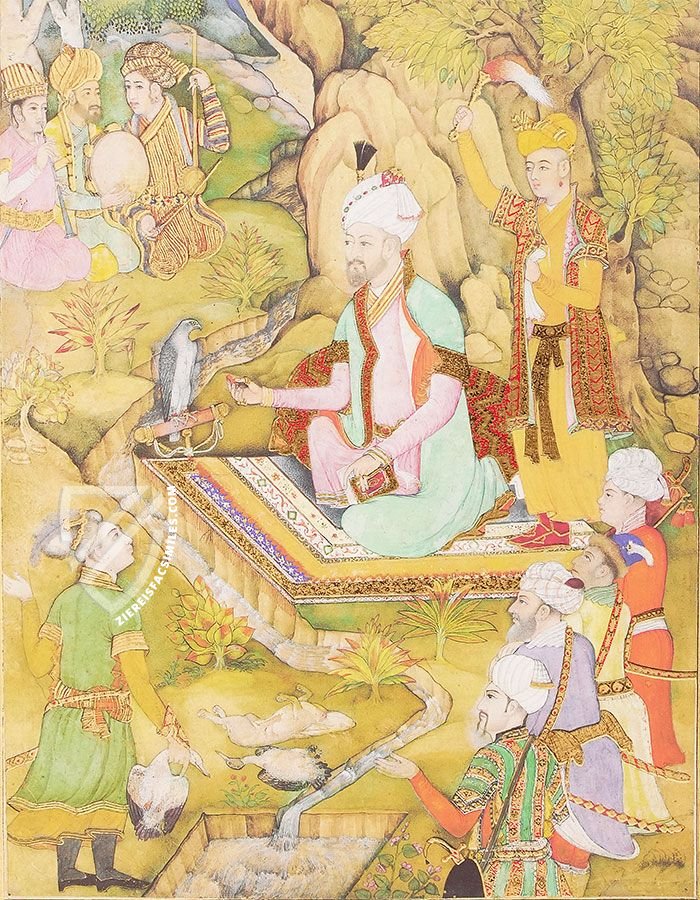
Masterpieces of the Mughal Era
Sultan Dara Shikoh and his Son on the Elephant Manmurt
This regal 18th century miniature depicts Dara Shikoh, the eldest son and heir-apparent of the Mughal Emperor Shah Jahan as well as an enlightened patron of the arts, riding with his son on the back of their magnificently adorned elephant, Manmurt. Aside from being highly naturalistic, this image is magnificently detailed from the facial features, clothes, and jewelry of the two riders to the patterns of the rug to the almost sublime expression on Manmurt’s face.
Unfortunately, the story of Dara Shikoh is not a happy one. After the death of his father in 1657, a dynastic crisis broke out and Dara Shikoh was defeated by his younger brother Prince Muhiuddin at the Battle of Samugarh on the 29th of May 1658. Dara Shikoh was then betrayed and handed over to his enemies, who put him in chains and paraded him through the streets of Deli on a filthy elephant in mockery of his former station before finally being assassinated in front of his terrified son on the 30th of August 1659.
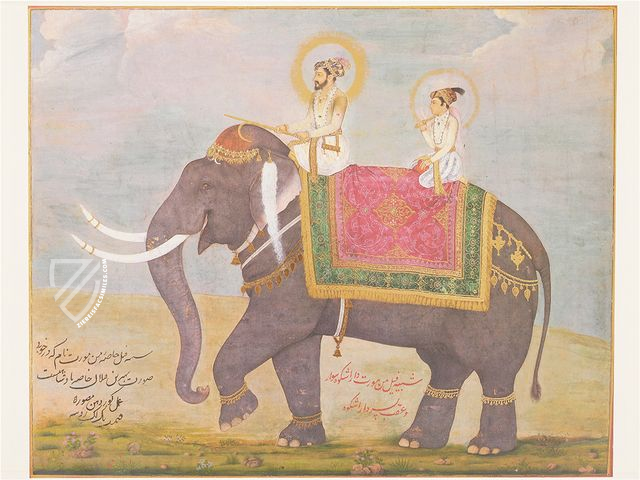
#1 Kassette Meisterwerke der Moghulzeit
Language: German
(under 1,000€)
- Treatises / Secular Books
- Apocalypses / Beatus
- Astronomy / Astrology
- Bestiaries
- Bibles / Gospels
- Chronicles / History / Law
- Geography / Maps
- Saints' Lives
- Islam / Oriental
- Judaism / Hebrew
- Single Leaf Collections
- Leonardo da Vinci
- Literature / Poetry
- Liturgical Manuscripts
- Medicine / Botany / Alchemy
- Music
- Mythology / Prophecies
- Psalters
- Other Religious Books
- Games / Hunting
- Private Devotion Books
- Other Genres
- Afghanistan
- Armenia
- Austria
- Belgium
- Belize
- Bosnia and Herzegovina
- China
- Colombia
- Costa Rica
- Croatia
- Cyprus
- Czech Republic
- Denmark
- Egypt
- El Salvador
- Ethiopia
- France
- Germany
- Greece
- Guatemala
- Honduras
- Hungary
- India
- Iran
- Iraq
- Israel
- Italy
- Japan
- Jordan
- Kazakhstan
- Kyrgyzstan
- Lebanon
- Liechtenstein
- Luxembourg
- Mexico
- Morocco
- Netherlands
- Palestine
- Panama
- Peru
- Poland
- Portugal
- Romania
- Russia
- Serbia
- Spain
- Sri Lanka
- Sweden
- Switzerland
- Syria
- Tajikistan
- Turkey
- Turkmenistan
- Ukraine
- United Kingdom
- United States
- Uzbekistan
- Vatican City
- A. Oosthoek, van Holkema & Warendorf
- Aboca Museum
- Ajuntament de Valencia
- Akademie Verlag
- Akademische Druck- u. Verlagsanstalt (ADEVA)
- Aldo Ausilio Editore - Bottega d’Erasmo
- Alecto Historical Editions
- Alkuin Verlag
- Almqvist & Wiksell
- Amilcare Pizzi
- Andreas & Andreas Verlagsbuchhandlung
- Archa 90
- Archiv Verlag
- Archivi Edizioni
- Arnold Verlag
- ARS
- Ars Magna
- ArtCodex
- AyN Ediciones
- Azimuth Editions
- Badenia Verlag
- Bärenreiter-Verlag
- Belser Verlag
- Belser Verlag / WK Wertkontor
- Benziger Verlag
- Bernardinum Wydawnictwo
- BiblioGemma
- Biblioteca Apostolica Vaticana (Vaticanstadt, Vaticanstadt)
- Bibliotheca Palatina Faksimile Verlag
- Bibliotheca Rara
- Boydell & Brewer
- Bramante Edizioni
- Bredius Genootschap
- Brepols Publishers
- British Library
- C. Weckesser
- Caixa Catalunya
- Canesi
- CAPSA, Ars Scriptoria
- Caratzas Brothers, Publishers
- Carus Verlag
- Casamassima Libri
- Centrum Cartographie Verlag GmbH
- Chavane Verlag
- Christian Brandstätter Verlag
- Circulo Cientifico
- Club Bibliófilo Versol
- Club du Livre
- CM Editores
- Collegium Graphicum
- Collezione Apocrifa Da Vinci
- Comissão Nacional para as Comemorações dos Descobrimentos Portugueses
- Coron Verlag
- Corvina
- CTHS
- D. S. Brewer
- Damon
- De Agostini/UTET
- De Nederlandsche Boekhandel
- De Schutter
- Deuschle & Stemmle
- Deutscher Verlag für Kunstwissenschaft
- DIAMM
- Droz
- E. Schreiber Graphische Kunstanstalten
- Ediciones Boreal
- Ediciones Grial
- Ediclube
- Edições Inapa
- Edilan
- Editalia
- Edition Deuschle
- Edition Georg Popp
- Edition Leipzig
- Edition Libri Illustri
- Editiones Reales Sitios S. L.
- Éditions de l'Oiseau Lyre
- Editions Medicina Rara
- Editorial Casariego
- Editorial Mintzoa
- Editrice Antenore
- Editrice Velar
- Edizioni Edison
- Egeria, S.L.
- Eikon Editores
- Electa
- Emery Walker Limited
- Enciclopèdia Catalana
- Eos-Verlag
- Ephesus Publishing
- Ernst Battenberg
- Eugrammia Press
- Extraordinary Editions
- Fackelverlag
- Facsimila Art & Edition
- Facsimile Editions Ltd.
- Facsimilia Art & Edition Ebert KG
- Faksimile Verlag
- Feuermann Verlag
- Folger Shakespeare Library
- Franco Cosimo Panini Editore
- Friedrich Wittig Verlag
- Fundación Hullera Vasco-Leonesa
- G. Braziller
- Gabriele Mazzotta Editore
- Gebr. Mann Verlag
- Gesellschaft für graphische Industrie
- Getty Research Institute
- Giovanni Domenico de Rossi
- Giunti Editore
- Graffiti
- Grafica European Center of Fine Arts
- Guido Pressler
- Guillermo Blazquez
- Gustav Kiepenheuer
- H. N. Abrams
- Harrassowitz
- Harvard University Press
- Helikon
- Hendrickson Publishers
- Henning Oppermann
- Herder Verlag
- Hes & De Graaf Publishers
- Hoepli
- Holbein-Verlag
- Houghton Library
- Hugo Schmidt Verlag
- Idion Verlag
- Il Bulino, edizioni d'arte
- ILte
- Imago
- Insel Verlag
- Insel-Verlag Anton Kippenberger
- Instituto de Estudios Altoaragoneses
- Instituto Nacional de Antropología e Historia
- Introligatornia Budnik Jerzy
- Istituto dell'Enciclopedia Italiana - Treccani
- Istituto Ellenico di Studi Bizantini e Postbizantini
- Istituto Geografico De Agostini
- Istituto Poligrafico e Zecca dello Stato
- Italarte Art Establishments
- Jan Thorbecke Verlag
- Johnson Reprint Corporation
- Josef Stocker
- Josef Stocker-Schmid
- Jugoslavija
- Karl W. Hiersemann
- Kasper Straube
- Kaydeda Ediciones
- Kindler Verlag / Coron Verlag
- Kodansha International Ltd.
- Konrad Kölbl Verlag
- Kurt Wolff Verlag
- La Liberia dello Stato
- La Linea Editrice
- La Meta Editore
- Lambert Schneider
- Landeskreditbank Baden-Württemberg
- Leo S. Olschki
- Les Incunables
- Liber Artis
- Library of Congress
- Libreria Musicale Italiana
- Lichtdruck
- Lito Immagine Editore
- Lumen Artis
- Lund Humphries
- M. Moleiro Editor
- Maison des Sciences de l'homme et de la société de Poitiers
- Manuscriptum
- Martinus Nijhoff
- Maruzen-Yushodo Co. Ltd.
- MASA
- Massada Publishers
- McGraw-Hill
- Metropolitan Museum of Art
- Militos
- Millennium Liber
- Müller & Schindler
- Nahar - Stavit
- Nahar and Steimatzky
- National Library of Wales
- Neri Pozza
- Nova Charta
- Oceanum Verlag
- Odeon
- Orbis Mediaevalis
- Orbis Pictus
- Österreichische Staatsdruckerei
- Oxford University Press
- Pageant Books
- Parzellers Buchverlag
- Patrimonio Ediciones
- Pattloch Verlag
- PIAF
- Pieper Verlag
- Plon-Nourrit et cie
- Poligrafiche Bolis
- Presses Universitaires de Strasbourg
- Prestel Verlag
- Princeton University Press
- Prisma Verlag
- Priuli & Verlucca, editori
- Pro Sport Verlag
- Propyläen Verlag
- Pytheas Books
- Quaternio Verlag Luzern
- Reales Sitios
- Recht-Verlag
- Reichert Verlag
- Reichsdruckerei
- Reprint Verlag
- Riehn & Reusch
- Roberto Vattori Editore
- Rosenkilde and Bagger
- Roxburghe Club
- Salerno Editrice
- Saltellus Press
- Sandoz
- Sarajevo Svjetlost
- Schöck ArtPrint Kft.
- Schulsinger Brothers
- Scolar Press
- Scrinium
- Scripta Maneant
- Scriptorium
- Shazar
- Siloé, arte y bibliofilia
- SISMEL - Edizioni del Galluzzo
- Sociedad Mexicana de Antropología
- Société des Bibliophiles & Iconophiles de Belgique
- Soncin Publishing
- Sorli Ediciones
- Stainer and Bell
- Studer
- Styria Verlag
- Sumptibus Pragopress
- Szegedi Tudomànyegyetem
- Taberna Libraria
- Tarshish Books
- Taschen
- Tempus Libri
- Testimonio Compañía Editorial
- Thames and Hudson
- The Clear Vue Publishing Partnership Limited
- The Facsimile Codex
- The Folio Society
- The Marquess of Normanby
- The Richard III and Yorkist History Trust
- Tip.Le.Co
- TouchArt
- TREC Publishing House
- TRI Publishing Co.
- Trident Editore
- Tuliba Collection
- Typis Regiae Officinae Polygraphicae
- Union Verlag Berlin
- Universidad de Granada
- University of California Press
- University of Chicago Press
- Urs Graf
- Vallecchi
- Van Wijnen
- VCH, Acta Humaniora
- VDI Verlag
- VEB Deutscher Verlag für Musik
- Verlag Anton Pustet / Andreas Verlag
- Verlag Bibliophile Drucke Josef Stocker
- Verlag der Münchner Drucke
- Verlag für Regionalgeschichte
- Verlag Styria
- Vicent Garcia Editores
- W. Turnowski Ltd.
- W. Turnowsky
- Waanders Printers
- Wiener Mechitharisten-Congregation (Wien, Österreich)
- Wissenschaftliche Buchgesellschaft
- Wissenschaftliche Verlagsgesellschaft
- Wydawnictwo Dolnoslaskie
- Xuntanza Editorial
- Zakład Narodowy
- Zollikofer AG

